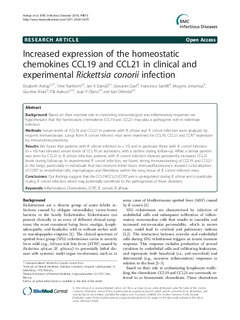Increased expression of the homeostatic chemokines CCL19 and CCL21 in clinical and experimental Rickettsia conorii infection
Astrup, Elisabeth; Ranheim, Trine; Damås, Jan Kristian; Davi, Giovanni; Santilli, Francesca; Jensenius, Mogens; Vitale, Giustina; Aukrust, Pål; Olano, Juan P; Otterdal, Kari
Journal article, Peer reviewed
Permanent lenke
http://hdl.handle.net/11250/2358184Utgivelsesdato
2014Metadata
Vis full innførselSamlinger
Sammendrag
Background: Based on their essential role in concerting immunological and inflammatory responses we
hypothesized that the homeostatic chemokines CCL19 and CCL21 may play a pathogenic role in rickettsiae
infection.
Methods: Serum levels of CCL19 and CCL21 in patients with R. africae and R. conorii infection were analyzed by
enzyme immunoassays. Lungs from R. conorii infected mice were examined for CCL19, CCL21 and CCR7 expression
by immunohistochemistry.
Results: We found that patients with R. africae infection (n = 15) and in particular those with R. conorii infection
(n = 16) had elevated serum levels of CCL19 on admission, with a decline during follow-up. While a similar pattern
was seen for CCL21 in R. africae infection, patients with R. conorii infection showed persistently increased CCL21
levels during follow-up. In experimental R. conorii infection, we found strong immunostaining of CCL19 and CCL21
in the lungs, particularly in individuals that had received lethal doses. Immunofluorescence showed co-localization
of CCR7 to endothelial cells, macrophages and fibroblasts within the lung tissue of R. conorii infected mice.
Conclusions: Our findings suggest that the CCL19/CCL21/CCR7 axis is up-regulated during R. africae and in particular
during R. conorii infection, which may potentially contribute to the pathogenesis of these disorders.
